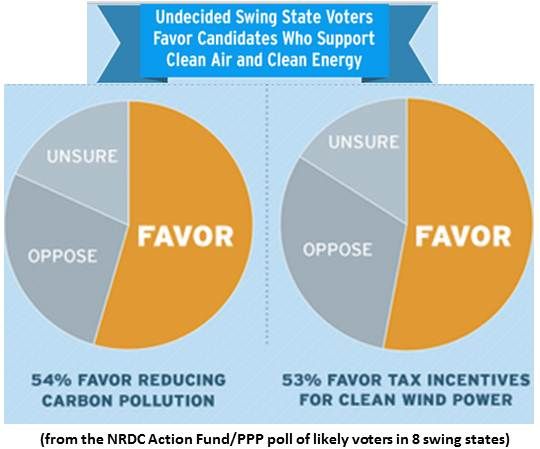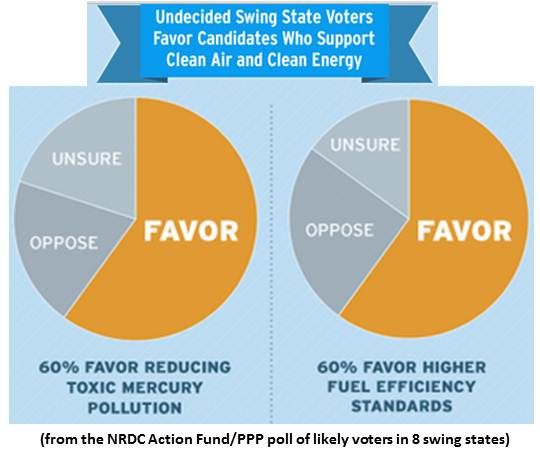Recently, GTM asked how the results of the 2012 election will impact U.S. greentech, but a new poll suggests that question put the horse before the cart. The first question is how greentech will impact the 2012 election.
Public Policy Polling (PPP) asked 22,412 likely voters in eight states considered to have the potential to swing either Republican or Democrat in November -- Florida, Michigan, Nevada, New Mexico, Ohio, Pennsylvania, Virginia and Wisconsin -- how they felt about “clean air and clean energy policies” and how candidates’ positions on those issues might affect their vote.
Using a sample large enough to keep the margin of error below 1 percent, according to PPP Director Tom Jensen, the poll found that, by a margin of 54 percent to 27 percent, undecided voters in those eight crucial states favored President Obama (“a candidate who supports EPA standards to reduce dangerous carbon pollution”) over Governor Romney ("a candidate who says these limits would be bad for business and EPA should not limit carbon pollution”).
This suggests, Jensen said, that while Mr. Romney needs to make up a 6 percent deficit among likely voters in those eight states (50 percent to 44 percent), “his stances on environment and energy issues could hurt his ability to do that.”
The real question is whether the voters isolated in these new polls will vote on these issues. Polls have long shown greentech topics to be what politicians call "80 percent issues." They get such overwhelming approval from the public it is hard to understand why there is so much controversy.
The question of whether voters think about greentech issues was highlighted in the PPP poll by the fact that the undecided voters polled, when pressed for a choice, went for Romney 32 percent to 20 percent, apparently despite their opinions on energy and the environment. And 48 percent remained unable to choose even when pressed, despite the fact that, as Jensen noted, “Romney’s views are at odds with the very centrist voters he needs.”

Those views, which have been documented as antithetical to Romney's positions by GTM, extend to federal vehicle fuel efficiency standards, EPA mercury pollution controls, and incentives for wind and solar energy.
“Undecided voters have a wide variety of things on their minds,” Jensen acknowledged. “What these poll numbers show is that Governor Romney is out of the mainstream and too conservative, and his positions on these issues are not going to help his cause.”
“Polluters and their allies are spending tens of millions of dollars attacking clean air and clean energy,” noted poll sponsor Natural Resources Defense Council Action Fund’s Director Heather Taylor-Miesle, referencing a recent New York Times report that “fossil fuel industries have spent $153 million dollars to unseat President Obama” by attacking his pro-greentech policies.
And, Jensen added, the Los Angeles Times recently reported that “five of every seven attack ads in the eight swing states” was about the poll’s environmental and energy topics.
“But the reality on the ground in these crucial swing states is that likely voters are not buying what the polluters are selling,” Taylor-Miesle said. “The people who will decide this election -- the undecided -- are not in the market.” Or it could be that they are not very interested in greentech issues.
That highlights the question of why candidates and PACs are running the ads. Miesle-Taylor offered an explanation. “They could be talking to donors,” she suggested, “and that speaks to how they would govern.”

A few other key PPP poll findings:
- Undecided voters in the eight swing states support a presidential candidate who favors higher fuel efficiency standards for vehicles by 60 percent to 25 percent. For likely voters, that is 60 percent to 31 percent.
- Undecided voters support a presidential candidate who favors increased incentives for wind power by 52 percent to 29 percent. For likely voters, that is 56 percent to 35 percent.
- The PPP poll also looked at Senate races in the eight swing states that could determine which party comes out of the election with control of Congress.
- Undecided voters support congressional candidates who favor “reducing dangerous carbon pollution from power plants” by 55 percent to 27 percent. For likely voters, that is 57 percent to 33 percent.
- Undecided voters support congressional candidates who favor “increased incentives for wind power” by 53 percent to 31 percent. For likely voters, that is 57 percent to 34 percent.
- Finally, PPP polled on likely voters’ opinions about EPA regulation of the oil and natural gas drilling technique of hydraulic fracturing (fracking).
- Undecided voters agree that the EPA should protect air and water with “safeguards that hold corporate polluters accountable” by 72 percent to 14 percent and favor “disclosure of chemicals used in fracking” by 68 percent to 17 percent. For likely voters, it is 69 percent to 21 percent.



